Frozen Cable Time (Again)
Tweet
Workcycles bikes demonstrating that they’re not spring flowers. They’re built to live like this.
This is a slightly updated repost: Winter is upon us somewhat early this year and this is highly relevant info for anybody who cycles through the winter, especially if your bike is stored outdoors.
By far the most common problem that the cyclist encounters with winter cycling is the brake or gear cables freezing. This is generally the result of water condensing or dripping into the cable housing and then freezing, effectively bonding the inner cable to the housing. It only takes a tiny bit of water to do this but we fortunately have a solution. Read below for an explanation.
………………………………………………………………………………
We arrived at work yesterday figuring that the sub-zero cold, wind and snow would keep most of the customers away, leaving us with time to work on some projects. The highest priority is reconfiguring our workshop after building a massive, floor-anchored, steel frame to hang our electric bike lifts from. It’s a great improvement but not entirely our own initiative. The lifts, you see, were bolted into the 150 or 200 year old wooden beams of our ceiling… and thus the floor of the neighbors upstairs. Though the lifts are nearly new and operate very quietly they do make some vibration. Standing on the concrete (over sand) floor we never noticed this vibration but it drove the lady upstairs crazy. Actually she’s complained very vocally and angrily about a lot of things, apparently calling and writing every possible authority on a regular basis. Most of her complaints have nothing to do with our activities (there’s another bike workshop next door and several apartments have been renovated), but the vibration was a legitimate issue according to the various city inspectors who visited to investigate.
So the city ordered the building owner (a social housing corporation that manages tens of thousands of properties) to fix the vibration problem. It was decided that the only solution was to totally isolate the lifts from the floor beams, and the only practical way to do that was to build a steel frame all the way to the floor. We’re very fortunate and thankful that they took care of the job and paid for it. But it still requires an investment of several days of our labor to refit the lifts and lights. We took the opportunity to make them fully adjustable on both X and Y axis as well as angle, and now we’re adding more lights. I don’t think a workshop can ever have enough light.
Comments one year later: Apparently the frame has solved the vibration problem since we haven’t heard a peep from our upstairs neighbor. Meanwhile the mechanics are very happy to have been able to adjust the lifts to exactly the location and angle where they can most efficiently and comfortably work.
For those of you who build and repair (heavy) city and transport bikes: Such lifts are absolutely the only way to work. These bikes are much too heavy and unwieldy to manually heft into the workstands used in most bike shops outside the Netherlands. Those are intended for lighter, recreational bikes. The lifts are also highly flexible; You can lift only the front or rear, or perhaps one side of a big three wheeler. When working on something other than bikes you can simply raise the hooks above head height and then you’ve lots of free floor space – often really handy in a shop that builds and repairs wooden boxes.
Anyhow, this is all we were thinking about yesterday morning so I got busy with the scaffold, drills, plugs, screws and wiring to hang the fluorescent boxes on our ancient ceiling. And then the first snowy Cargobike and customer came in:
Customer: “My bike is almost impossible to ride. It’s really slow, and I think the brake lever might be broken.”
Mechanic: “I’m pretty sure your cables are frozen.”
Customer: “But I think there’s also something wrong with the brake.”
Mechanic: “The brakes are probably fine but they’re being locked by the frozen cables.”
Customer: “Oh wait, now it seems to be fine.”
Mechanic: “Sure, your bike is indoors so the cable just thawed, releasing the brake. It’ll freeze again a few moments after going outside. If you can wait 15 minutes I’ll fix it.
While working on this bike another snowy bike came in with the same problem, and so it went the whole day. Alexis and I pulled and flushed the cables of at least 15 bikes yesterday. The problem is that Amsterdam bikes live outdoors, rain or shine. Tiny amounts of water drip and condense into the cable housings. On good quality bikes the cables are stainless steel and the housings are lined with polyethelene or another low friction plastic so the water doesn’t make much difference… until the thermometer goes below the freezing point. Then the cable freezes inside the housing. Usually it creates enough friction that pulling hard on the brake lever will overcome the friction, actuating the brake but the brake’s return spring cannot pull it back… thus locked brakes.
So here’s what you do to fix (or prevent) a frozen cable:
-
1. Let it thaw.
-
2. Remove the crimped end cap and make sure the end of the cable isn’t unwound or damaged. If it is either rewind, shorten or replace the cable as necessary.
-
3. Remove any kinks in the cable so that it can easily be pulled and reinserted through the housing.
-
4. Pull the cable out.
-
5. Seal the nozzle of a compressed air pistol against the upper end of the housing and blow everything possible out of the housing.
-
6. Seal the dispenser straw of a suitable light oil against the brake lever end of the housing. It might be necessary to pull the housing cap to do this. We use a generic multipurpose oil with teflon but just about any light oil should work fine. Don’t use “dry” type lubricant because it won’t displace the water for long.
-
7. Spray the oil into the housing until it begins coming out the other end.
-
5.5 Oops. Put a rag at the brake end of the housing to catch the oil coming out at great velocity.
-
8-9-10. Thread the cable back into the housing, readjust the brake and crimp a new end on.
This fix is valid for any brake (or gear) cable but I’m basically assuming the bike has roller brakes here. Drum brakes can pull their own freezing tricks and rim brakes simply aren’t suitable for storing outdoors and riding in snow country. Now the techies can ask me why I didn’t write anything about disk brakes.
This experience also demonstrates something about Amsterdam cyclists: Not only do they store their bikes on the street, they also ride in ALL conditions including snow. Of course they do; How else would they get to work, take the kids to school, do the groceries and visit their friends?
Speaking of snow, here’s a sneak peek at our surprising new development: The WorkCycles Child Transport Sled. We’re strong proponents of the K.I.S.S. philosophy (Keep It Simple Stupid) and our Sled meets the K.I.S.S. criteria beautifully: It needs no wheels, tires, bearings, towing linkage or even harnesses. Just shove the kid in and go! It’s versatile too: You can pull it while walking, tie the patented “S.T.R.A.P.” (Singular Tied/Releasable Attaching Piece-of-plastic-webbing) to your bike or even have your dog(s) or oxen pull it from a yoke. When there’s no snow it can be attached to the front carrier of your bike as a convenient transport bin.
In testing the WorkCycles sled we also learned that Amsterdammers not only ride their bikes all year round in all conditions, they can also make really big snowballs.

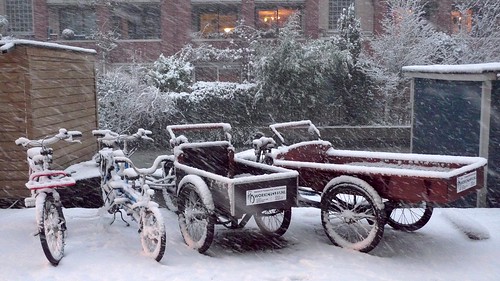
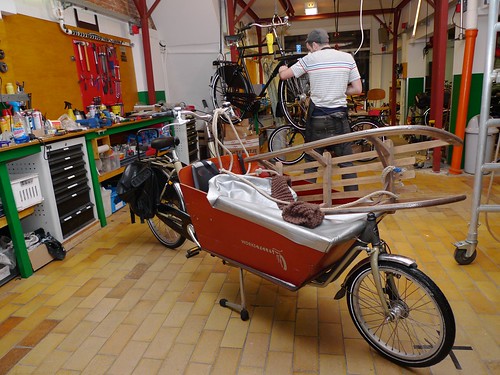


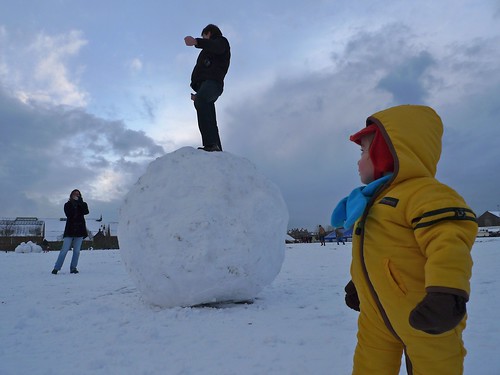
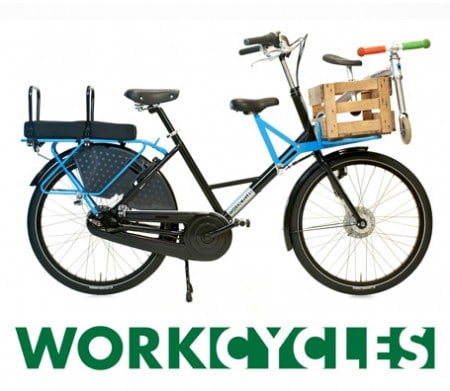
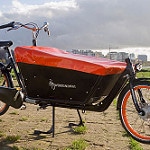















December 8th, 2010 at 13:23
Great to read you again. I saw the superdad balancing 2 kids on his Fr8 again this morning on my freezing-rain Paris commute, he’s quite persistent. Neither he, his two kids, or me, are made of sugar. (then some asshole fishtailed me, but let’s not get into this)
December 8th, 2010 at 13:23
LOL!
December 10th, 2010 at 10:11
Does this solution usually work for a whole winter (or longer) and was it only brake problems that came in or shift/deraileur problems as well? I had the problem once last winter when it cold rrreally cold.
December 10th, 2010 at 11:04
Todd,
In theory it should be good for the whole winter but occasionally the mechanic can miss a tiny bit of water or more can drip in later… and then it’s unfortunately back to step 1.
December 10th, 2010 at 12:17
Hmm… so some inexpensive or at least reliable solution operating on the K.I.S.S. principle which could be used every time one parked a bike outside in winter could be useful?
December 10th, 2010 at 16:46
Having been so nicely given clearance, why didn’t you write anything about disk brakes? Frozen cables might never be a problem for hydraulic-actuated disk brakes (or maybe those can freeze too), but what about cable-actuated disk brakes?
Is it the living-outdoors situation that makes disk brakes unsuitable for cargo/transport bikes, or is it something else? Are the gaps between the pads and the rotor so small that water can tend to stick there due to capillary action?
I’ve never ridden with disk brakes myself but elsewhere on the internet, they seem to be well-liked by some bike commuters and others who ride through the winter.
December 10th, 2010 at 23:26
Ike,
Yes, cable actuated disks will suffer from the same cable freezing problem, as can any gear cable. I expect that their exposed mechanisms will also be freeze prone. The capillary action you suggest might also be relevant. At this point though it’s anybody’s guess since few (non motor-) bikes with disk brakes are being left outdoors. Why is that? I’ll speculate that, like workcycles, most manufacturers feel that the existing bicycle disk brake systems just aren’t fit for the rough outdoor life. On the few disk braked bikes we have dealt with (mainly Christianias) the disks have been a nightmare: misaligned disks rubbing the pads, disks getting bent from abuse, disks rusting and making scraping noises…
Of course I’m not arguing against the concept of disk brakes, and not even disk brakes on bikes… just not moderately priced disk brakes on bikes that live outdoors.
December 13th, 2010 at 16:13
A couple of years ago, your dutch colleagues of “Flevobike” tested hydraulic
and mechanical disc brakes under dutch winter conditions. They wanted to
find the toughest possible solution for their “greenmachine” recumbent.
As a result the full-hydraulic type brakes failed in the long run under the influence of salt in thawed snow and ice. The pads simply stuck from corrosion. This didn´t happen on the mechanical operated type.
Unfortunately Johan and his crew could never stop to justify installing
“inferior” disc brakes on their bike.
The “christiania” standard disc brake is actually horrible. The german importeur`s advice is to pay 30 EUR on top to get a good working upgrade
December 15th, 2010 at 06:43
Timely re-post.
Brakes were fine last night on the cold, wet ride home. Unlocked this morning to find the rear brake “jammed” which made for a difficult ride in with the brake stuck most of the time. Rather than lock up outside as usual, I brought it inside, dreading dealing with a brake repair. By the time I got off the elevator on the 8th floor it worked fine. A few minutes later when I thawed out a bit, I realized the brake cable had done the same.
December 17th, 2010 at 19:04
Thanks so, so much for this step-by-step instruction on how to deal with this problem! It couldn’t have been better timing for me, and worked perfectly. It also enabled me to see and seal some cracks in my cable housing which were likely causing the problem in the first place!
January 3rd, 2011 at 17:32
Hello,
I have come across your site from time to time and I really enjoy it. My name is Chuck. I represent Biking.com, a site for all things biking. I was curious if you accept advertising or sponsorships at all on your site. I would love to sponsor your blog with a text ad for Biking.com.
Please contact me via this email should an opportunity become available.
Thank you and happy new year!
-Chuck
Biking.com
February 5th, 2011 at 08:23
While using oil does work I find that it eventually dries up and has to be redone annually, so I have started injecting regular bearing grease into the casing. It is a tad messier to do, but stays done much longer.
February 17th, 2011 at 10:07
i hate disk brakes. just sayin’.
February 17th, 2011 at 16:05
Disk brakes have their place… but not on bikes that live outdoors and get tossed around in racks.
For a perfectly tuned trials bike or mountain bike for sloppy conditions nothing beats a set of high-end, hydraulic disks.
January 21st, 2013 at 12:36
Just wanted to share my $0,02 on oiling brake/gear cables.
If the bottle/dispenser doesn’t have one of these awesome straws –or some other contraption that makes it easy to let the oil slip into the cable housing– I always work like this:
Put about 30cm of cable inside the housing from the brake lever end. Now let the oil stream/drip along the cable into the housing. Keep dripping and gradually insert the cable further inside the housing. This will make sure that there is oil inbetween the housing and the cable and doesn’t give you a big oily mess. Watch out when the cable comes out of the other end, you might want to put a rag there 😉
Success!